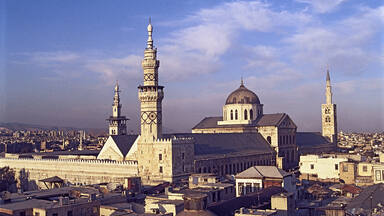The Lure of Mysterious Damascus
By: Habeeb Salloum/Arab America Contributing Writer
The Byzantine Emperor Justinian called it ‘the light of the orient’, and the writer Maurice Barres is reported to have said ‘Damascus is not a mere area of land, it is the place of the soul’. The Prophet Muhammad reportedly refused to enter the city which he labelled ‘Heaven on earth’. He preferred to wait for the Heavenly Paradise.

Through the centuries, such have been the epithets with which men have described Damascus – the oldest continuously inhabited spot on earth is said to be a town with a lasting secret. When all the modern cities were forests, swamps, and desert land this venerable metropolis was a thriving city. It has lived on for hundreds of years while other urban centres have crumbled into dust.
The site was inhabited since the dawn of recorded history. Three thousand years ago it was the capital of the Arameans who called it ‘the holy and the great’. The hieroglyphics of the Pharaohs, Assyrian texts and the Bible mention this historic city. Damascus also played a vital role in the Roman, Byzantine and early Christian eras.
However, the golden age of the city was under the Umayyads when it was the capital of a vast Arab empire which stretched from the borders of China to the heart of France. Under this illustrious dynasty Damascus reached its height of glory. As a proud capital of a huge empire, it radiated its influences to the four corners of the earth. In the succeeding centuries, although still important, it never reached the splendour of its hundred years under Umayyad rule. It was to be only in this century when it became the capital of independent Syria that a measure of its former greatness returned.
Modern Damascus, a beautiful city of over 2,500,000, is fast expanding up the slopes of Mount Kassioun. Decades ago, this mountain towering over the city below was only a barren hill. Today, roads, buildings but above all thousands of newly planted trees have transformed it into a charming, wooded part of Syria’s capital. Wealthy Damascenes have left the old romantic city to build their new abodes on its slopes. Below them Damascus is like an enticing jewel surrounded by the green oasis of the Ghouta purported to be the legendary Garden of Eden – a legend given credence by the location of Abel’s tomb a few miles from the city.
Giving life to the endless fields, orchards, and gardens of the Ghouta is the river Barada springing out of the desert at the foot of the nearby mountains. Its waters provide a coolness and freshness to the Damascene air and its banks have provided relaxation spots to the people of Damascus through the ages. Near its waters, restaurants and night entertainment centres are found in endless numbers. In these places of leisure, especially during the summer months, hordes of Damascenes and tourists spend enjoyable hours.
Damascus is a city which combines both past and present. Surrounded by the beauty of nature, it is intriguing and overwhelming in its atmosphere. Ancient historical buildings; holy spots; picturesque modern edifices; tree-lined streets; majestic hotels; hundreds of world-renowned artisans at their daily tasks; and its inhabitants dressed in the costumes which range from the robes of the desert to the modern dress of the West, make the city one of the most colourful metropolises on earth.
At the pinnacle of its many attractions is the 110 x 170-yard Umayyad Mosque, the pride and joy of Damascus. Built in 705 A.D. on the location of a Basilica which itself was erected on the ruins of a former pagan temple, it is a masterpiece of Arab/Islamic architecture. Some of its admirers have described it as the finest work of art of all ages and in any country. The fourth holy place in the Muslim world, it enchants a visitor with its minarets, domes, altars, and exquisite colours. Its beautiful decoration of finely made mosaics represents the climax of Arab art and genius. The mausoleum of John the Baptist called by the Muslims Yahya, lies within its walls and it has a vast finely proportioned cool courtyard. Stepping out of the noisy streets into the tranquility of the mosque is one of the most moving experiences to be found. In the last few years buildings clinging to the outer walls have been removed and today, the mosque can be viewed on the outside, the first time this has been possible in centuries.
Near the Umayyad Mosque is the Azem Palace, once the home of Syria’s viceroys. Built in 1750, it is a superb example of the old wealthy homes in Damascus. Today, this old Arab home houses the Syrian Museum of the Arts and Popular Traditions. In its numerous restored rooms are relics from Syrian life during the past few hundred years.
A more interesting place for a historian to visit in Damascus is the National Museum, considered one of the most perfectly organized museums in the world. The historic remains inside its walls are an exhibition of human history. They tell the story of the civilizations which flourished in the Middle East from the beginning of man until our times. On its shelves are exhibited invaluable art treasures, including statues of gods and kings, some 5000 centuries old.
Across the street from the National Museum is Al-Takkiya Al-Sulaymania, a collection of a mosque, a souk for the traditional handicrafts and a military museum. Built in the 16th century by the Ottomans, the whole complex was once a religious compound. Its mosque is of the most beautiful religious buildings in the world.
Other historic spots in the city which are worth a lingering visit are the Saint Hanania, an underground church named after a saint who it is said cured the eyes of St. Paul; the Church of Saint Paul, forming a part of the old city ramparts which was erected to commemorate Saint Paul’s miraculous escape from the Romans by way of a small window in the walls; the Citadel of Damascus, built in 1216 by the brother of Saladin; the Science and Medical Museum housed in the Birmistan of Nur al-Din; Bab al-Saghir, a graveyard which contains many of the mausoleums of the Prophet Muhammad’s family and the tomb of Muawiya, the first and greatest of the Umayyad Caliphs; the tomb of the famous Saladin next door to the Umayyad Mosque; and the Adelia, Zahiria and Jumukjia schools built between the 12th and 13th centuries.
After a visitor tires of exploring historical structures, there remain the ancient avenues. The Street Called Straight, known in Arabic as Bab Sharqi, was in Roman times the hub of the city. Today, this mile long street intersected at right angles with laneways is little changed from the days of Imperial Rome. Each of the connecting alleyways specializes in a certain product and all connect with Souk al-Hamadiah, one of the most popular shopping markets in the East and famous as far away as the Americas. The whole street, built by the Ottomans about a hundred years ago, is roofed and banned to traffic. Famous for the handmade goods sold by its merchants, it is a mecca for tourists. From all over the world they come to purchase the famous Damascus brocade, damask fabrics and inlay works of brass, ivory, and silver. However, in our modern age, intermixed with these world-famous handmade works of art are the plastic trinkets and other machine-made products of the West. Nevertheless, they only appear to add colour to the historic products produced for centuries. Some tourists journey to Damascus only to shop in this Souk that a number of writers have asserted is the prototype of the western supermarket.
When shoppers have had enough of shopping and venerable sites, they can relax in the courtyard of an old Damascene home amid fruit trees and the perfume diffusing Rosa Damascena – a rose of Damascus which has been transplanted to the four corners of the world. The natural calm beauty and the enticing atmosphere of the setting makes the heart begin to beat and become overwhelmed with an ambiguous sweet nostalgia. Here the visitor can dream of old and new Damascus – a jewel on earth and an eternal mysterious city with a magic effect.



